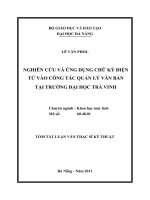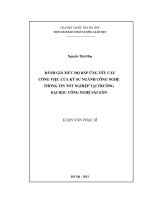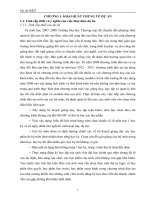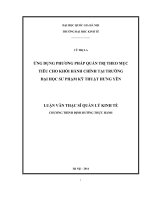ỨNG DỤNG KỸ THUẬT NHẬN DẠNG KÝ TỰ ĐÁNH DẤU DÙNG CHO PHIẾU KHẢO SÁT TẠI TRƯỜNG ĐẠI HỌC ĐÀ LẠT
Bạn đang xem bản rút gọn của tài liệu. Xem và tải ngay bản đầy đủ của tài liệu tại đây (971.66 KB, 11 trang )
<span class='text_page_counter'>(1)</span><div class='page_container' data-page=1>
<b>APPLICATION OF OPTICAL MARK RECOGNITION </b>
<b>TECHNIQUES TO SURVEY ANSWER SHEETS </b>
<b>AT DALAT UNIVERSITY </b>
<b>Thai Duy Quya*<sub>, Phan Thi Thanh Nga</sub>a<sub>, Nguyen Van Huy Dung</sub>a</b>
<i>a<sub>The Facuty of Information and Technology, Dalat University, Lam Dong, Vietnam </sub></i>
<i>*<sub>Corresponding author: Email: </sub></i>
<b>Article history </b>
Received: November 18th<sub>, 2020 </sub>
Received in revised form: December 22nd<sub>, 2020 | Accepted: December 29</sub>th<sub>, 2020 </sub>
Available online: February 5th<sub>, 2021 </sub>
<b>Abstract </b>
<i>In this paper, we examine some image processing techniques used in optical mark </i>
<i>recognition, and then we introduce an application that collects data automatically from </i>
<i>survey answer sheets at Dalat University. This application is constructed with the Aforge </i>
<i>framework. Two types of survey answer sheets are used as input forms for our application: </i>
<i>the teaching quality and the administrative quality survey answer sheets. Results show that </i>
<i>our application has good performance in recognizing handwritten marks, with an accuracy </i>
<i>of 98.9% per 667 answer sheets. Moreover, this application is clearly a time-saving solution </i>
<i>for administrative staff because the inputting process is now nine times faster than before. </i>
<b>Keywords: Computer vision; Image processing; Optical mark recognition; Survey answer </b>
sheet.
DOI:
Article type: (peer-reviewed) Full-length research article
Copyright © 2021 The author(s).
</div>
<span class='text_page_counter'>(2)</span><div class='page_container' data-page=2>
<b>1. </b> <b>INTRODUCTION </b>
Nowadays, automation techniques help to enhance the speed and efficiency of
information processing and communication. Since their inception, automation techniques
have undergone many development stages and have made great advances in technical and
scientific calculations as well as in administrative management (Ngô & Đỗ, 2000). One
of the focus areas for automation is image recognition, in which information is
automatically retrieved from handwritten data. This technique is used in optical character
recognition, optical mark recognition (OMR), invoice identification, postal code
recognition, automatic map recognition, music recognition, face recognition, and
fingerprint identification, etc. Each type of application has its own processing techniques
based on the characteristics of the input data and serves different purposes in many areas
of life. This article mainly explores and examines some techniques in optical mark
recognition.
Optical mark recognition is a technique that uses a computer to retrieve data from
handwriting or hand-filled answer sheets (Bergeron, 1998; Cip & Horak, 2011; Kumar,
2015; Popli et al., 2014; Surbhi et al., 2012; Yunxia et al., 2019). The technique is used
for collecting information from surveys and answers to multiple choice questions. The
technique can also be integrated with image scanners, which are specialized in scanning
and identifying different types of answer sheets.
The OMR technique was invented in the 1960s by American scientists. IBM's
computer systems were used to process questionnaires after images were scanned into the
computer (Yunxia et al., 2019). Today, this technique has been researched and applied in
many different fields, such as exam marking, timekeeping, survey evaluations, vote
identification, etc. (Surbhi et al., 2012). The main concepts concerning the objects used
in mark recognition, such as data areas, personal areas, and calibration points are
discussed by Cip and Horak (2011). For effective optical mark identification, de Elias et
al. (2019), Kumar (2015), and Surbhi et al. (2012) have proposed several general
techniques, such as binary transformation, image rotation, and shifting. Yunxia et al.
(2019) used a convolution neural network and the Tensorflow library to study
identification methods for answer sheets with various characteristics.
Domestically, the OMR technique has been studied by Ngô and Đỗ (2000) by
applying preprocessing techniques on images of the MarkRead system. Mai (2014)
developed a recognition application used for survey answer sheets at the Vietnam
National University of Forestry. In addition, some commercial identity systems have been
built, such as TickREC and IONE. However, these versions are commercial and cannot
be applied to the current survey questionnaires at Dalat University.
</div>
<span class='text_page_counter'>(3)</span><div class='page_container' data-page=3>
without convolution operations. The EmguCV library, developed from OpenCV, also
supports image processing, but does not have strong built-in support for the convolution
operations matrix. We examined the Aforge library and found that it is not only a free
library that supports many techniques for image preprocessing, but that it also supports
image convolution, which makes it suitable for our application.
<b>2. </b> <b>METHODOLOGY </b>
<b>2.1. </b> <b>The survey answer sheets </b>
We selected two types of survey answer sheets that are used at Dalat University,
namely, the student survey on teaching quality and the student survey on the
administration and departments (Figure 1). These answer sheets are much used each
semester to help the university's teaching and administration become more effective.
After receiving the students’ answers, the staff must manually process the results in a
Microsoft Excel file and then make a statistical summary based on the numbers. Due to
the large number of survey answer sheets, this task is time consuming and boring.
(a) (b)
<b>Figure 1. Two types of survey answer sheets used at Dalat University </b>
Note: a) The student survey on teaching quality; b) The student survey on the administration and departments.
</div>
<span class='text_page_counter'>(4)</span><div class='page_container' data-page=4>
apply a number of convolution techniques for image preprocessing based on the
characteristics of the scanned images. After the preprocessing, we continue by applying
the OMR method to detect handwriting and to build an application.
<b>2.2. </b> <b>Convolution techniques </b>
Convolution is a technique of image processing used to transform the image
matrix to a result matrix related to the original image. This technique is used in
transformations on images, such as smoothing, boundary extraction, and filtering. The
convolution formula is represented as follows:
−
= =−
−
−
= /2
2
/
2
/
2
/
)
,
(
)
,
(
)
,
(
*
)
,
(
<i>m</i>
<i>m</i>
<i>u</i>
<i>n</i>
<i>n</i>
<i>v</i>
<i>v</i>
<i>y</i>
<i>u</i>
<i>x</i>
<i>f</i>
<i>v</i>
<i>u</i>
<i>k</i>
<i>y</i>
<i>x</i>
<i>f</i>
<i>y</i>
<i>x</i>
<i>k</i> (1)
<i>where f(x,y) is an image matrix and k(x,y) is a filter matrix with dimensions (mn). </i>
An important component in the convolution Equation (1) is the filter, which is
called the kernel matrix. The filter's anchor point is located at the center of the matrix,
and it determines the corresponding matrix area on the image for convolution (Kim,
2016). The convolution method moves the kernel matrix over the pixels around the anchor
point, then calculates the result matrix with the convolution Equation (1) (Figure 2).
<b>Figure 2. Convolution operation illustration </b>
Source: Kim (2016).
<b>2.3. Aforge platform </b>
</div>
<span class='text_page_counter'>(5)</span><div class='page_container' data-page=5>
they can simply add some *.dll files needed for their project. The powerful platform
supports effective image processing and recognition with built-in convolution operations
and basic pixel image methods.
<b>3. </b> <b>RECOGNITION TECHNIQUES </b>
<b>3.1. Recognition diagram </b>
Figure 3 shows a diagram of the OMR technique used in our application. The
process includes the following steps: First, the answer sheets are converted to images and
stored in the computer. Second, the scanned images are preprocessed to become binary
images. After that, the application will determine the anchor points (also called calibration
marks), which are located at certain positions on the binary image. The frame trimming
step is then used to cut images by blocks based on the anchor points from the previous
step. In the next step, the application uses a histogram to read the pixel image and
recognize the hand-filled answers. Finally, statistical results are provided to the user.
<b>Figure 3. OMR technique diagram </b>
<b>3.2. Image preprocessing </b>
Preprocessing of images is used to transform the image pixels before the
recognition stage. For highly efficient and accurate recognition results, we apply several
techniques, including image rotation, grayscale transformation, noise filtering, and image
<i>binarization. </i>
• <i>Image rotation: The scanning process may skew images, so the image </i>
must be rotated vertically before the recognition process. We rely on the Hough
transform (Phan et al., 2017) to find the angle of inclination (), then rotate the
image in the opposite direction (-). This process makes the image upright and
easy to identify in the next steps.
• <i>Grayscale image: Grayscale is an image that has only two colors, black </i>
and white, with the colors represented by shades of gray from light to dark. We
apply the transformation formula from Đỗ and Phạm (2007) to convert from color
images to grayscale:
</div>
<span class='text_page_counter'>(6)</span><div class='page_container' data-page=6>
where the R, G, and B values represent red, green, and blue, respectively, and ,
, and have many possible values. According to Kumar (2015), the tuple
( = 0.2125, = 0.7154, and = 0.0721) is appropriate for mark recognition on
multiple choice answer sheets. When applied to our program, we saw that
Kumar’s tuple gave better results than others.
• <i>Noise filtering: Scanned images may have noise. To reduce this problem, </i>
we apply a convolutional filter with the median filter (Yang, 2006). This operation
is supported by the Aforge library. This process helps our application reduce noise
in the image, thereby increasing the accuracy of the recognition process.
• <i>Sharpen: The sharpen convolution technique increases the accuracy of </i>
recognition by giving a sharper image. The kernel matrix of this method,
according to Abraham (2020), is
−
−
−
−
0
1
0
1
5
1
0
1
0 <sub>. </sub>
• <i>Image binarization: Binarization is a process that transforms a pixel in </i>
grayscale to a pixel that has only two values: black (1) and white (0). The formula
for the conversion is as follows:
<i>g(x,y) = {1 if f(x,y) ≥ T</i>
<i>0 otherwise</i> <i>(3) </i>
<i>where f(x, y) is a function that represents the value at the position (x, y) of the </i>
image, and T is the threshold that has values from 0 to 255. After experimenting
<i>with our application, we determined that a T value of 250 is suitable for clarifying </i>
pixels when the students make fuzzy marks or small strokes when filling in
answers with pencils. This is the default value of our program. The user can
change this parameter as desired when using the program.
<b>3.3. Calibration mark recognition </b>
According to Cip and Horak (2011), calibration marks are points used to locate
position on the answer sheets. The calibration marks are usually placed at the corners and
are a circle or square shape. Finding these points is the first step in the recognition process.
From these points an application locates the position of the sheet, from which rows,
columns, and cells can be determined and cut. This action is the basis for taking image
areas, analyzing pixels, and recognizing data from the image pixels.
</div>
<span class='text_page_counter'>(7)</span><div class='page_container' data-page=7>
−
−
−
−
−
−
1
1
1
2
2
2
1
1
1
and
−
−
−
−
−
−
2
1
1
1
2
1
1
1
2
, respectively. These matrices are used in the convolution
method, which determines the nearest horizontal or vertical line of the scanned image
from the top and the left side. The lines form a basis to determine the area of the image
to be cropped for the next steps of the OMR process. When using the boundary detection
technique, all the calibration points on the front and back side are determined at this time,
so the image area can be cropped on both sides of the answer sheet.
<b>3.4. Image cropping process </b>
The image of a scanned survey answer sheet consists of three blocks: The first
block includes personal information and instructions. The second block is the handwriting
area consisting of questions and boxes for marking answers, and the final block is the area
for the students' opinions. After determining the calibration point, the scanned image will
be cut based on these three blocks (Figure 4).
<b>Figure 4. Cutting the three blocks of the scanned image </b>
In some cases, the block is too small after cropping, so the software will zoom in
to an appropriate size for more accuracy in the next steps. The blocks are cut by our
application as follows:
• <i>Information and student’s opinion blocks: These blocks are cut according </i>
to the position determined by the calibration points and saved to the system. When
the software displays the results of each image, the student’s opinion block can be
deleted if it is blank.
• <i>Handwriting block: The handwriting block is also cut by positioning the </i>
</div>
<span class='text_page_counter'>(8)</span><div class='page_container' data-page=8>
answers on each side of each image, then the application will cut each question
and answer box by column and row. The student survey answer sheet on teaching
quality has 18 questions on the front and 5 questions on the back, while the student
survey answer sheet on the administration and departments has 16 questions on
the front and 15 questions on the back. Each question on the two answer sheets
has five answer options.
<b>3.5. </b> <b>Recognizing image blocks </b>
To recognize the handwritten marks in the answer blocks, we apply the histogram
to the image of each answer box. This diagram depends on two colors: black and white.
The main color used for comparison is black. We analyze the number of black pixels per
<i>answer block and compare it with the given threshold. Variable sbp is the total number </i>
<i>of black pixels, and T is the threshold value to distinguish marked cells. If sbp ≥ T, then </i>
the cell is read as marked by the student; otherwise the cell is read as not marked.
<i>Experimentation with our software determined that T = 960 is a suitable value to </i>
guarantee the accuracy of the recognition process (Figure 5).
<b>Figure 5. Example of a filled-in answer mark by a student </b>
<b>4. </b> <b>EXPERIMENTATION RESULTS </b>
</div>
<span class='text_page_counter'>(9)</span><div class='page_container' data-page=9>
<b>Figure 6. Experiment program </b>
We used 677 survey answer sheets provided by the Quality Assurance and Testing
department for the second term of the 2019-2020 school year. The sheets are classified
and grouped by class and faculty. Due to security reasons, we used the concept of Lot
instead of the class name. Survey files were scanned and the size of each image was
2,550 x 3,300 pixels. The experimental results showed that 98.9% of the images were
correctly recognized. There was some incorrect recognition because of noise in the
scanning process (Figure 7a) or because of a large image angle. In addition, there were
many questionnaires that were invalid because students did not fill in an answer or filled
in more than one answer per question (Figure 7b). The results of the program are given
in Tables 1 and 2.
<b>Table 1. Results of the student survey on teaching quality </b>
Lot Quantity
Recognition results <sub>Timing </sub>
(seconds)
Invalid sheets Invalid responses
L1 26 3 3 156
L2 46 6 10 276
L3 29 3 5 174
L4 76 11 11 456
L5 113 27 29 678
L6 75 9 15 450
L7 23 3 5 138
L8 28 2 2 168
L9 27 2 4 162
L10 32 5 7 192
</div>
<span class='text_page_counter'>(10)</span><div class='page_container' data-page=10>
<b>Table 2. Results of the student survey on the administration and departments </b>
Lot Quantity Recognition results Timing
(seconds)
Invalid sheets Invalid responses
L1 26 3 8 156
L2 46 6 10 276
L3 29 3 9 174
L4 76 11 11 456
L5 25 27 30 150
<b>Total </b> <b>202 </b> <b>50 </b> <b>68 </b> <b>1,212 </b>
(a) (b)
<b>Figure 7. Examples of invalid responses </b>
Notes: a) Image has noise; b) Invalid answer.
Tables 1 and 2 show that the total time for processing 677 survey answer sheets
was 4,062 seconds. When added to the time to process the incorrect results (assuming
each incorrect result takes 3 seconds), the total processing time is 4,539 seconds. The total
input time for the staff, assuming that each form takes 60 seconds, is 40,620 seconds.
Thus, using the software will be about 9 times faster, not including the time for sorting
the survey answer sheets and calculating the statistics.
<b>5. </b> <b>CONCLUSION </b>
In this article, we have handled the recognition of survey answer sheets by
applying a number of convolution image processing techniques, such as edge detection,
noise filtering, and image sharpening. Combining the convolution operations with an
optical mark reader, we have built a recognition program and have automatically read two
types of answer sheets used at Dalat University. The program reads faster than manual
input, gives accurate results, and allows erroneous results to be corrected quickly.
In the future, we will improve the program in a general way to read more types of
forms. This improvement helps increase work efficiency for university staff. We also
propose to redesign the survey sheets with calibration points at the four corners for easier
and more convenient reading.
<b>REFERENCES </b>
</div>
<span class='text_page_counter'>(11)</span><div class='page_container' data-page=11>
<i>Bergeron, B. P. (1998). Optical mark recognition. Postgraduate Medicine, 104(2), 23-25. </i>
<i>Cip, P., & Horak, K. (2011). Concept for optical mark processing. Paper presented at the </i>
22nd International DAAAM Symposium, Austria.
<i>de Elias, E. M., Tasinaflfo, P. M., & Junio, R. H. (2019). Alignment, scale and skew </i>
<i>correction for optical mark recognition documents based. Paper presented at the </i>
2019 XV Workshop de Visão Computacional (WVC), Brazil.
<i>Đỗ, N. T., & Phạm, V. B. (2007). Xử lý ảnh. Trường Đại học Thái Nguyên. </i>
<i>Kim, U. (2016). Phép tích chập trong xử lý ảnh (convolution). https:// www.stdio.vn </i>
/computer-vision/phep-tich-chap-trong-xu-ly-anh-convolution-r1vHu1
<i>Kumar, S. (2015). A study on optical mark readers. International Interdisciplinary </i>
<i>Research Journal, 3(11), 40-44. </i>
Mai, H. A. (2014). Nghiên cứu ứng dụng kỹ thuật xử lý ảnh vào xử lý phiếu đánh giá môn
<i>học Trường Đại học Lâm nghiệp. Tạp chí Khoa học và Công nghệ Lâm nghiệp, </i>
(1), 141-146.
Ngô, Q. T., & Đỗ, N. T. (2000). Một số phương pháp nâng cao hiệu quả nhận dạng phiếu
<i>điều tra dạng dấu phục vụ cho thiết kế hệ nhập liệu tự động MarkRead. Tạp chí </i>
<i>Tin học và Điều khiển học, 16(3), 65-73. </i>
Phan, T. T. N., Nguyen, T. H. T., Nguyen, V. P., Thai, D. Q., & Vo, P. B. (2017).
<i>Vietnamese text extraction from book covers. Dalat University Journal of </i>
<i>Science, 7(2), 142-152. </i>
<i>Popli, H., Parekh, H., & Sanghvi, J. (2014). Optical mark recognition. de </i>
share.net/HimanshuPopli/optical-mark-recognition-40292822
<i>Sinha, U. (n.d). Image convolution examples. </i>
<i>Surbhi, G., Geetila, S., & Parvinder, S. S. (2012). A generalized approach to optical mark </i>
<i>recognition. Paper presented at the International Conference on Computer and </i>
Communication Technologies (ICCCT'2012), Thailand.
<i>Yang, Y. (2006). Image filtering: Noise removal, sharpening, and deblurring. </i>
<i>Yunxia, J., Xichang, W., & Xichang, C. (2019). Research on OMR recognition based on </i>
<i>convolutional neural network Tensorflow platform. Paper presented at the </i>
</div>
<!--links-->
Giáo trình : Kỹ thuật Môi trường. Đại học Đà Lạt
- 94
- 1
- 7








